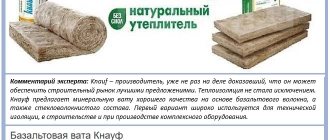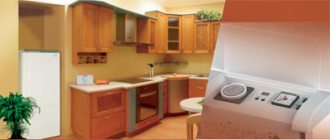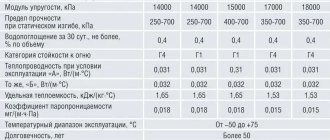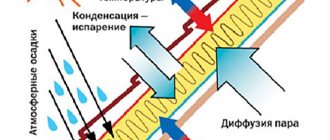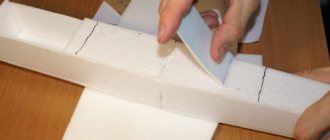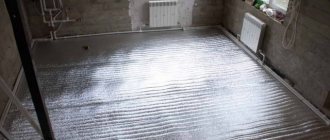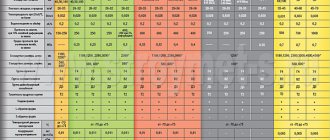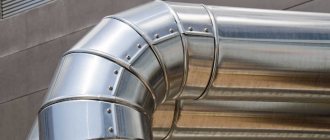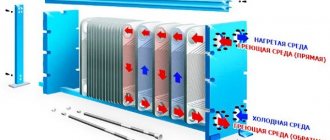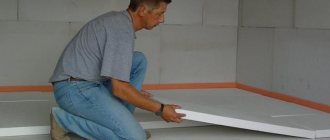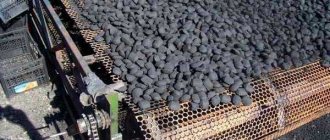Scope of application of insulation in rolls
It is successfully used for roofs and basements, floors and ceilings, pipes and more. Installing thermal insulation from this material is a fairly simple process. Moreover, the work can be done independently, without the involvement of additional labor. Therefore, this type of thermal insulation has gained great popularity in private construction, in particular, bathhouses, outbuildings, etc.
Attention!
Insulation in rolls is not recommended for thermal insulation of vertical surfaces subject to high loads.
Scope of application of roll insulation
Roll insulation materials are used for thermal insulation of vertical and horizontal surfaces. Foil material is indispensable for creating thermal insulation in bath rooms, as it retains heat well and has heat-reflecting properties. This material has also found wide application for thermal insulation of individual structures, joints, and in hard-to-reach places.
Let's look at the main ways to use rolled heat insulators.
Rolled thermal insulation for walls
Rolled wall insulation can be used as a heat-insulating material applied under decorative finishing, including wallpaper.
The application technology is very simple:
- self-adhesive material is glued to a wall that has been prepared in advance, leveled and cleared of debris and old finishes;
- A cement-based adhesive is applied to the heat insulator layer, its properties reminiscent of liquid plaster;
- After the adhesive has hardened, you can begin gluing the wallpaper.
The use of such material for wallpaper will significantly increase the heat-retaining properties of the walls, as well as their sound insulation.
Rolled floor insulation
It is used as a substrate for various types of decorative floor coverings. It not only has heat-insulating properties, but also gives the floor “softness”, eliminates squeaks and sounds when the floor covering shrinks and moves.
In some cases, a foil thermal insulator can be used to insulate the floor; this will increase heat retention; however, the cost of materials reinforced with foil is 30–60% more expensive.
The technology for performing floor insulation work using foamed polymer in rolls is very simple:
- the material is glued to a wooden floor or concrete screed using an adhesive composition or self-adhesive properties;
- leveled so that there are no “bubbles”;
- The floor covering is laid on top.
The advantages of such a heat insulator include ease of installation, lack of debris, durability and environmental safety. When choosing a roll insulation for the floor, it is worth remembering that the “softer” the floor covering, the denser the insulation should be.
In other words, it is better to use a polymer with maximum density under linoleum, otherwise when you walk you will “sink” into the floor covering, but under laminate or parquet you can lay a polymer with any density.
Rolled roof insulation
Suitable for thermal insulation of pitched and flat roofs. A roof insulated with such material will remain warm for several decades. You can install thermal insulation on your own, without involving highly paid specialists. The heat insulator is located between the elements of the roof rafter system, and distortions, the formation of waves and other defects are not allowed.
In some cases, for example, when insulating a residential attic space or in regions with a cold climate, it is recommended to lay the insulating polymer in two layers.
The technology for installing roof thermal insulation depends on the design features. The best option is when thermal insulation is calculated at the design stage. In this case, the work boils down to rolling out the rolled material and gluing it to the inner surface of the roof, laying a layer of vapor barrier material on top and installing the final finish, for example, siding, lining, etc.
Types of roll insulation
Currently, roofers on flat roofs use roll materials that are fused. This is Bicroelast bitumen-polymer insulation. This method saves both installation time and the budget for purchasing materials.
Glass and basalt wool
These are excellent heat insulators with a long service life. However, glass wool is harmful to human health. Advantages of cotton wool: resistant to fire, high humidity and not susceptible to pests in the insulation. Of the minuses: such insulation is not recommended for use on roofs with a steep slope, since the wool will sag, which will subsequently lead to freezing at the ridge. At the same time, cotton wool packaged in rolls is convenient for transportation to the work site and does not take up a large volume.
An undoubted simplification of installation is the following fact: if the width of a roll of standard insulation is equal to the width of the roofing pitch. In this case, installation of the insulation takes place quickly, without the need to carefully monitor the joints of the material. Simply lay the rolls between the floor beams and secure them.
Foil-coated insulation
Manufacturers of thermal insulation materials use foil to cover the insulation on one side. This layer protects the insulation from the negative effects of ultraviolet rays and from moisture entering the insulation. It is best to use foil-coated insulation for work from inside the house. It is worth noting that manufacturers produce a wide variety of insulation materials with a layer of foil.
To avoid the formation of condensation and protect the room from heat loss and low temperatures, use foil insulators with low thermal conductivity.
Rubber, polyethylene foam, polystyrene
Significant advantages of such insulation include low thermal conductivity, long service life and ease of installation. Do not forget that they are used as additional insulation, as well as vapor and waterproofing. For convenience and speed up work, they are used in the form of rolls.
The role of the foil surface
The main feature of such insulating devices is the presence of a thin but durable foil coating. In this way, the material is protected from the negative effects of ultraviolet rays and high humidity, which is very important when equipping industrial premises, kitchens, bathrooms, baths, saunas.
Foil insulation withstands high temperatures well
Laying of foil insulation is carried out in accordance with a special technological process. A gap of 1-1.5 cm must be created between the thermal insulation and the finishing material. This is very important, since at elevated temperatures the insulation maintains a given degree by transferring it to the back wall and then returning it back to the walls, but not to the room.
In comparison with rolled materials made of slag wool, glass wool and basalt base, the foil product must be fixed to the lathing. The layers are overlapped, and their joints are carefully treated with insulation.
Overview of thermal insulation manufacturers
To a large extent, the quality of the insulating material depends on the manufacturer. Products from the following manufacturers are distributed.
Knauf is a famous German brand. It is based on natural mineral wool material created using the most modern ECOSE technology. It is environmentally friendly - it contains no formaldehyde. This material can also be used for interior decoration. Does not cause allergies upon contact with human skin. Has good heat and sound insulation characteristics.
In addition, Knauf products are different:
- Low hygroscopicity;
- Biological and chemical stability;
- Excellent insulating properties;
- Light weight of the material;
- Vapor permeability;
- The material is not flammable;
- Easy installation
The main disadvantage of Knauf insulation is its rather high price. The company produces a wide range of insulation materials for various purposes. There are two main lines of materials - Insulation - for professional construction work and TeploKnauf, for domestic use.
Products of the French company Isover . This is one inexpensive thermal insulation option. It is characterized by high density. Large range of insulator thicknesses - 2,3,5,10,15 cm.
Isover products are characterized by:
- Durability;
- Easy installation;
- The material is non-flammable and does not form toxic emissions when exposed to flame;
- High sound insulation performance;
- Environmentally friendly.
Among the disadvantages, it is necessary to mention high hygroscopicity. The material quickly absorbs water and loses its characteristics. In tandem with it, be sure to use a vapor barrier.
URSA is one of the common brands from Germany. Enjoys well-deserved popularity in Russia and Europe.
Advantages of URSA insulation:
- High heat and sound insulation qualities;
- Affordable price;
- Not subject to rotting;
- Light weight, which is important for the roof;
- Elasticity and ease of installation.
It is also known for its durability and mechanical strength. Practically does not crumble. Easy to install. Rolls have different thicknesses of material - 5,8,10 cm.
Flaws:
- High hygroscopicity - absorbs water well, but its properties deteriorate;
- Collects a lot of dust.
Mineral wool and types of insulation made from it
Roll insulation is a lightweight and easy-to-install material at a low cost.
The use of mineral wool in rolls for insulation of various structures is widely used due to the excellent thermal insulation properties of the material and ease of work with it, as well as other positive qualities: light weight, non-flammability and low cost.
Using mineral wool, supplied in rolls, you can quickly and easily insulate a floor or roof. However, for different cases, you should choose mineral wool with certain characteristics. The types of mineral wool include the following types of insulation:
- The structure of basalt insulation, supplied in compact rolls, is the finest fiberglass. It is obtained by melting rocks of mountain origin.
- The cheapest and still in demand variety is glass wool. The fibers of this insulation are made from waste from the glass industry. It can be wall or roof.
- Slag wool is made from waste from the metallurgical industry.
Basalt mineral wool in rolls is resistant to high temperatures, is not afraid of moisture, does not release toxins when heated, and is lightweight.
The peculiarity of glass wool is its non-flammability and high sound insulation properties. When working with this material it is necessary to wear gloves, goggles and a respirator to protect against fine glass dust. The downside is the lack of moisture resistance, so the insulation must be additionally protected from moisture, which is not always economically beneficial.
A special feature of rolled slag mineral wool is its low price and high heat and sound insulation properties. This type of rolled mineral wool insulation for walls has the highest density and weight.
Characteristics of roll insulators
Insulation in the form of layers and mats, such as mineral wool, is extremely inconvenient for insulating pipes, exhaust shafts and large areas. In such cases, roll thermal insulation materials are used. They are flexible when laid and quickly return to their original shape. It is roll insulation materials that are convenient to use in order to wrap the required insulated surface. Due to their structure, rolled materials are resistant to temperature changes and can withstand both extremely high temperatures (up to 700-750 °C) and extremely low ones. At the same time, the insulation retains all its qualities. Despite all the positive aspects, you cannot be sure of the quality of thermal insulation, because it directly depends on class=”aligncenter” width=”596″ height=”283″[/img]
Flexible thermal insulation in rolls
The material is affordable and has excellent performance properties. The scope of its application is renovation finishing and capital construction, when there is a need to increase the thermal insulation properties of surfaces:
- balcony;
- basement;
- gender;
- floors;
- attic.
Which insulation retains heat better:
There are roll-type insulation materials based on mineral wool, which are glued to the walls directly under the wallpaper. Their main purpose is to increase the temperature inside the room, reducing natural heat loss during the cold season. Additionally, such materials prevent the development of mold and mildew and the formation of high humidity. The uneven surface is perfectly masked due to the soft insulation, which does not require finishing work.
Characteristic features and differences of insulation:
The versatility of roll thermal insulation based on mineral wool determines a wide range of its use . It is indispensable in the modern construction industry ; it creates a durable working layer of insulation that protects from the cold:
- Living spaces;
- offices;
- warehouses at enterprises;
- outbuildings;
- baths and saunas.
Insulation, soundproofing of walls under wallpaper:
Soft thermal insulation is not damaged by regular contact with ventilation ducts and pipelines. Due to its sufficient flexibility, it tightly covers uneven surfaces and can be laid at sub-zero temperatures.
Material advantages
Thermal insulation in rolls is designed taking into account the disadvantages that characterize similar material in slabs. It has a number of positive aspects:
- Minimization of thermal conductivity even among models belonging to the budget class.
- A large assortment of roll insulation, the basis of which is various types of mineral wool. They differ in performance characteristics.
- No damage from rodents, fungi, microorganisms.
This is interesting: what kind of insulation will not be chewed by mice and rats.
The presence of a large assortment of insulation will allow you to choose the best one for you
- Resistance to temperature changes and adverse atmospheric conditions while maintaining the original thermal insulation properties.
- Noise-reducing feature, resulting in increased sound insulation in the furnished room.
- Resistance to open fire.
- Easy installation that even an inexperienced craftsman can handle.
Like other universal materials, soft insulation has a drawback. They are characterized by increased vapor conductivity, which an additional layer of vapor barrier will help eliminate.
Main types and characteristics
The main component of the materials described is usually mineral wool. It, in turn, is presented in several versions:
- Slag-like. The insulation is made from waste from the metallurgical industry. It is characterized by strength characteristics, while being the cheapest and most accessible product.
Slag wool is one of the cheapest materials that provides good thermal insulation.
- Basalt wool. The peculiarity of insulation in rolls for walls and other surfaces is that they are produced using rock melting technology. Then thin layers are formed from the resulting contents, woven into a single carpet.
- Glass wool. The heat insulator is created from pre-melted broken glass. This approach to the production process significantly reduces the final price of the products described.
Read also: basalt or mineral wool - comparison of insulation.
The disadvantage of glass wool is the increased fragility of the fibers, which cause itching.
Each of the designated insulation materials has a specific set of characteristics. But in any case, they all represent an improved version of standard mineral wool. For example, glass wool exhibits excellent resistance to high temperatures: a heat insulator made from it can withstand up to +400°C. Exceeding this mark entails complete destruction of the material with the impossibility of restoration.
Which insulation is better:
As for the highest rates of thermal conductivity and density, they are typical specifically for roll insulation made of glass wool. It tolerates vibrations well, does not smolder or burn, and absorbs sound vibrations.
Throughout the entire service life, there is no shrinkage of such material.
Among the unpleasant aspects, irritation of human skin upon contact with fiberglass wool and slight instability to moisture are noted.
The presence of pros and cons of each material will help you choose the best material for: home, cottage, bathhouse
Thermal insulation rolls made of basalt wool also withstand high temperatures and are characterized by sufficient density and thermal conductivity. Excellent resistance to high humidity. Even when completely wet, the original quality indicators are maintained. This material is completely environmentally friendly, does not cause irritation upon direct contact, and does not cause allergic reactions.
The heat insulator made of slag wool can withstand temperature loads not exceeding +300°C. Otherwise, the slag melts and the structure of the described building product is completely destroyed.
Rolled thermal insulation materials differ in parameters and functionality. It all depends on the product brand, manufacturer, and buyer requirements when making a custom product.
Characteristics of glass wool thermal insulation in roll form
Different manufacturers may have slightly different figures. However, when choosing insulation, pay attention to the following minimum values:
Material density – from 10 kg/m3 Thermal conductivity – from 0.37% Susceptibility to combustion – NG (non-flammable) Water absorption – from 16% Equilibrium humidity – from 3.4% Compressive stability – from 30 kPa. Scope of application of roll insulation Roll insulation can be used on a wide variety of surfaces. They will perfectly protect loggias and balconies, floors and ceilings. They are suitable for insulating homestead structures, basements and roofs. This material is very convenient for pipe insulation. High-quality insulation in the form of rolls will last up to 50 years, which is a good service life. You can carry out the installation yourself; you do not need the help of professionals. Because of this, such insulation materials are popular in construction on private plots; they are used to insulate bathhouses, outbuildings and other structures. It is not recommended to use rolled materials for insulating vertical coverings that are subject to high loads.
Note! Thermal insulation in the form of rolls is not suitable for insulating vertical surfaces that bear high loads.
Types and characteristics
Mineral wool insulation materials are widely used.
Their popularity is explained by their high operational and technical indicators and relatively low cost.
Roll insulation based on mineral wool includes:
- Basalt wool. The material is obtained by melting rocks of a certain type and forming thin fibers.
- Glass wool. Insulation made from molten broken glass is affordable. Thanks to this, the material is in high demand, although it is considered obsolete.
- Slag-like. The material is based on waste from the metallurgical industry, so it has a fairly low price.
Insulation based on mineral wool has its own distinctive properties:
- temperature resistance;
- low thermal conductivity;
- high density;
- absorption of vibrations and sound vibrations;
- no shrinkage after long-term use.
Foil roll insulation is made from expanded polystyrene foam by applying it to a layer of foil. The foil creates the effect of a thermos, pushing heat back into the room.
The main properties of foil roll insulation include:
- high thermal insulation;
- reliable vapor barrier;
- good noise absorption;
- fire safety;
- durability.
Intercrown roll insulation represents a rather specific solution. The main purpose is to fill the empty space between the crowns. Even high-quality assembly of houses from profiled timber or logs cannot guarantee a tight fit of the elements. An inter-crown heat insulator will fill the free space.
The material is produced in narrow rolls; natural and harmless materials such as linen, batting, and jute are used for its production. The use of this type of insulation is possible both during construction and during operation of the house. Everyone knows that over time, wood dries out, forming gaps between building elements. By filling the resulting voids with insulation using a chisel and mallet, you can retain maximum heat in the house.
Which insulation is best to use for a private home?
In private houses, the roofs are usually pitched, so when insulating it is better to focus on soft materials, leaving polystyrene foam and penoplex for external insulation of flat roofs. The final choice depends on the roof configuration and finishing material. For example:
- for complex-shaped roofs, polyurethane foam and ecowool are well suited, as they can provide a seamless coating;
- a roof with a continuous sheathing through which water is guaranteed not to leak can be insulated with any type of wool;
In private housing construction, cotton insulation is most widely used. - if the roof will be completely rebuilt, it is worth insulating it with expanded clay during construction;
- for a wooden house with high fire safety requirements, non-combustible materials are suitable - ecowool, expanded clay, fiberboard;
- in houses with a low attic it is necessary to save space, so it is worth using foil penofol or penotherm;
- when the roof is high with an acute angle, the wool can slide down, so it is better to insulate it with polyurethane foam, foam roll insulation or fiberboard.
When purchasing insulation, be sure to ask your consultant whether the type you have chosen is suitable for roofing, since wool, polystyrene foam, penoplex and other materials for roofs, walls and ceilings differ in density, size, thickness of the slabs and other characteristics. Take the time to read the information on the packaging - most manufacturers indicate the purpose of the material.
Calculation of roof thermal insulation: how many materials are required
The thickness of the thermal insulation of the roof, according to SNiP, must compensate for the energy losses of the building, so it is determined on the basis of the thermal conductivity coefficient of the selected material, but not less than 20 cm. If the thickness of the supporting structure is not enough to organize appropriate insulation, then a more efficient material with a low degree of thermal conductivity is used for thermal insulation.
To calculate the amount of insulation, it is necessary to measure the roof and determine its total area. Then it all comes down to simple arithmetic operations: divide the roof area by the total area of insulation in one package and multiply by the required number of layers. An additional 10% for cutting is added to the rounded number of packages.
Let's look at an example of how many packages of 6 m of insulation are needed to thermally insulate a roof of 80 m2.
80/6 x 3=40 packs +10%= 44 packs.
Thus, with these initial data, 44 packages of thermal insulation material will be needed to insulate the roof.
Installation - arrangement options
Insulation of an unheated attic ↑
The simplest type of roof insulation device is thermal insulation of an unheated attic, since insulation of roof slopes is irrational. The most reasonable thing in this case is to insulate the attic floor. Structurally, it is performed as follows:
- by attaching a vapor barrier to the joists with an overlap from below, they create an obstacle to moving steam;
- insulation is placed between the joists;
- so that you can move on the thermal insulation, it is either covered with a continuous flooring, or “paths” are laid from boards.
Thermal insulation must be constantly dried, so ventilation holes are provided in the gables, and waterproofing is installed under the roofing material to protect against possible leaks.
Insulation of a warm pitched roof ↑
Thermal insulation of a used attic or residential attic is somewhat more complicated. The insulation design, which also includes thermal insulation of slopes, is as follows:
INTERIOR FINISH
Any material is used for it according to the taste of the owner.
VAPOR INSULATION
Necessary to minimize the penetration of vapors from residential premises into the thermal insulation. The vapor barrier film consists of several layers of polyethylene in several layers and a reinforcing grid made of polyethylene or polypropylene. Fastening is carried out either using a stapler or strips.
It is important to always glue the joints with construction butyl tape.
When installing a vapor barrier, special attention is required to the junction units. They are also taped with butyl tape.
ROOF THERMAL INSULATION
The space between the rafters is filled with insulation of the calculated thickness. The calculations take into account the thermal conductivity coefficient and operating conditions of the pitched roof. Quite often, mineral wool (density 30-50 kg/cubic m) and staple fiberglass act as insulation. For additional fastening of fibrous materials, stretchers made of fishing line or rope are also used. If the height of the rafters is not enough to lay insulation of the required thickness, it is increased by adding timber to the rafters.
WATERPROOFING INSULATION
The main function of this layer is protective: firstly, against leaks of the roof covering, and secondly, against condensation that forms on some of its types. For waterproofing use:
- a hydrobarrier made similarly to a vapor barrier made of PE layers with a reinforcing lattice, with the difference that to remove steam, it has additional micro-perforations and cone-shaped punctures. During installation, a gap of several centimeters is maintained between the thermal insulation and the hydrobarrier.
- a superdiffusion membrane, the vapor permeability of which is very high compared to a film hydrobarrier. It is laid without any gaps directly on the heat-insulating layer.
VENTILATED CLEARANCE
An air gap must be provided above the waterproofing layer for ventilation, through which steam that escapes from the insulation through the waterproofing is removed. The vents are located on the roof eaves and ridge.
SUB-STRUCTURE FOR ROOF COVERING
As a rule, laying the roofing requires the installation of sheathing - solid or lattice with a certain pitch.
ROOF COVERING
Roofing material is selected according to the requirements of operating conditions.
Roof insulation with foam plastic
Polystyrene foam is one of the most popular thermal insulators because it is one of the cheapest. The slab material is easy to transport and install, does not overload the roof structure, and is completely unaffected by moisture, so it is not afraid of rot and mold.
Polystyrene foam is the best option for external insulation, so it is worth choosing if the roof of your house is flat . It will help to insulate the roof without losing internal space. If you bought an attic above your apartment in a multi-storey building, you can increase its height from 2.2–2.3 to 2.5–2.6 m only by transferring the heat insulator to the outer layer. True, for this you will have to agree on similar work with other residents of the top floor or with the management company.
This material is quite dense, it is not afraid of water, so builders also use foam plastic for thermal insulation of floors. Expanded polystyrene slabs are poured into the screed when arranging the floor in the attic.
However, when internally insulating the roof between the rafters, the disadvantages of foam plastic are revealed:
- the slabs are not elastic, so there are gaps between them that need to be filled with foam;
- expanded polystyrene interferes with the ventilation of rafters and other wooden frame elements, which can lead to their destruction by rot or fungus;
- polystyrene foam has a fairly low degree of sound insulation, so if it is important for you to cut out unnecessary sounds, it is better to choose less dense insulation;
- if the thickness of the material is incorrectly calculated, the dew point ends up inside the insulated space and the heat-insulating cake begins to collapse;
- modern polystyrene foam does not support combustion, but melts at high temperatures and releases toxic substances, so if a stove or fireplace pipe passes through the attic, it is better to insulate the space around it with another material.
In addition, polystyrene foam is unpleasant for many to work with, since when cutting and rubbing with hard surfaces it makes repulsive sounds (a similar reaction is caused by the grinding of metal on glass).
Use polystyrene foam for external insulation of facades, roofs, ceilings and protect it from atmospheric influences. Only in such a situation will expanded polystyrene provide reliable thermal insulation and not show its shortcomings.
By the way, when installing a green roof with grass and ornamental plants, foam plastic is used for thermal insulation, because it does not deform under the weight of subsequent layers of drainage and soil.
Roof insulation with penoplex
From a chemical point of view, Penoplex is a new generation of foam plastic. This material is produced in the form of hard orange slabs with no visible granules. What distinguishes it from the usual expanded polystyrene:
- tongue-and-groove edge, which helps to join the slabs without gaps, so there is no need to foam the seams and then trim the foam;
- higher density, due to which the roof increases resistance to snow loads;
- homogeneity, due to which the slab does not crumble when cut;
- lower thermal conductivity, which allows you to reliably insulate the slope with a 2 times smaller layer of insulation and maintain the ceiling height in the attic.
From its older brother, penoplex inherited water and steam resistance, immunity to the influence of fungi and bacteria, the ability to serve for a long time and the absence of dust when cutting. It can also be installed in any weather and humidity level. It is allowed to install penoplex without insulating membranes.
But despite all the efforts of the manufacturer to rid the material of flammability, the polymer remains dangerous in case of fire. Of course, it will not ignite on its own and will not burn without direct contact with fire, but the smoke released during melting can poison the residents of the house.
What types of roll insulators are there?
The first type of insulation, made in the form of rolls, is mineral wool materials. The cotton wool itself is on the following basis:
- Made from cullet and quartz. This is the so-called glass wool, which is so often found in Soviet-built houses.
- From rocks (for example, basalt);
- Cotton wool from blast furnace waste.
Glass wool is not recommended at all, as it is only suitable as the cheapest option for sealing cracks, for example. The material is very harmful to breathe.
It is recommended to use slag insulation only on the outside of walls, since there it does not cause any harm to health. But basalt products, in principle, can be laid indoors, the main thing is to put a vapor barrier on top of them so that small fibers do not get into the air.
As for whether to insulate walls with basalt wool from the outside or better from the inside, there is also no definite answer. The fact is that the material is afraid of moisture and if you install it from the facade, you need to make good external protection (for example, from a vapor barrier and a metal profile). And this is expensive - if you already have such means, then it is better to use polystyrene foam or cotton wool in the form of slabs.
But in general, basalt roll insulation is still more relevant for use on the indoor side, because it lasts longer and is of better quality. The main principle of action here is heat retention, that is, cotton wool prevents it from quickly escaping.
The second group is thermal insulation made of foamed polyethylene or polypropylene. The material is also produced in the form of rolls and comes in two types:
- with foil coating;
- with metallized outside.
The first insulation is good because it has a good level of resistance to mechanical stress and reflects heat well. Due to this, the solution is suitable for indoor use, for example, you can mount the sheet behind radiators to retain heat. Disadvantages include poor vapor permeability and the fact that foil of sufficient thickness is expensive.
In addition, this thermal insulation is not suitable for direct contact with concrete walls - alkali simply corrodes the foil.
Metallized products allow steam to pass through well, but they do not reflect heat effectively. It is relevant to use for covering the walls of shower rooms and rooms with high humidity. By the way, the coating here cannot be called durable at all - the slightest mechanical impact and the metal begins to “peel off” from the base of the insulation. Now we can move on to the most important question.
Roof insulation with polyurethane foam
Polyurethane foam is also a close relative of expanded polystyrene, but unlike the latter, it is not sold in finished form. The chemical reaction that creates the polymer pimples already takes place on your roof, so polyurethane foam is guaranteed to fill the smallest gaps between the rafters. In addition to providing a uniform, seamless coating, the material has other advantages:
- high thermal, hydro and sound insulation without cold bridges with a moderately thick layer of material, which allows you to maintain the height of the ceiling (the final thickness is three times less than when using polystyrene foam or cotton wool);
- no need for additional work (installation of fasteners, sheathing), dust removal and surface priming are sufficient;
- fire safety (the material does not support combustion, does not melt at temperatures up to +220o C);
- suitable for the northernmost regions (normal operating temperature up to -150o C);
- not afraid of fungus and rot.
Experts note that if the material is protected from ultraviolet radiation, polyurethane foam insulation can last more than 30 years.
What don't sellers tell you? For example, that polyurethane foam should absolutely not be applied directly to the roofing material or the membrane adjacent to it. Since the foam sticks tightly to the base, it becomes impossible to create the ventilation gap necessary for these materials, and the roof covering is slowly destroyed. Of course, you can line the slope with membrane-protected boards or OSB boards at a short distance from the main covering and apply foam to this covering. But such events will inevitably lead to an increase in the cost of the project, so some craftsmen prefer not to mention the nuances when talking with homeowners.
Insulation with polyurethane foam is impossible without special equipment, so when comparing materials, take into account the costs of the work of craftsmen. While laying polystyrene foam or cotton wool can be done with your own hands, you definitely won’t be able to spray polyurethane foam yourself.
If we take into account all the requirements of the technology, polyurethane foam turns out to be a very good choice for all types of houses and roofs, because it is not without reason that in Europe and the USA it is considered the most popular thermal insulator.
Roll insulation Penofol
Penofol is a reflective insulation.
Penofol is a heat-insulating roll material consisting of two layers: a base of foamed polyethylene and aluminum foil. It is used for interior work, the concept is to fight off infrared radiation. It is very effective in a steam bath, for houses and apartments where IR radiation is insignificant, and gives a slight insulating effect. Manufacturers position the polyethylene foam base as:
- damper to protect the foil;
- thermal insulation – the base can reach a thickness of 10 mm;
- waterproofing – the closed-cell structure does not allow water to pass through;
- sound insulation - absorbs not only sounds, but also vibration.
Penofol can be self-adhesive, which greatly simplifies its installation. It is used for walls, horizontal ceilings, insulation of air ducts and pipelines. It is rather weak as the main thermal insulation, but in tandem with other materials it shows good results. When installing, you need to remember one important point - you cannot lay the foil part of the penofol close to other surfaces. That is, there must be a ventilation gap of at least 15 mm between the finish and the shiny side, otherwise the concept of repelling IR radiation does not work.
A modern double-circuit parapet gas boiler heats not only water in the heating circuit, but also in the DHW system.
You can read about how to choose a good heated towel rail here.
Roof insulation with expanded clay
Expanded clay (foamed clay granules) attracts attention with the following properties:
- environmentally friendly (it consists entirely of mineral components without the addition of polymer resins and other popular binders);
- resistance to mouse teeth (it simply does not attract the interest of rodents, who happily make nests in mineral wool and polystyrene foam);
- long service life (50–60 years is not the limit for expanded clay);
- extremely low thermal conductivity (a layer of 10 cm of expanded clay insulates heat like 25 cm of timber or 100 cm of brick).
At the same time, the cost of the material is not exorbitant; it is considered one of the most budget-friendly insulation materials.
The disadvantage of expanded clay is that it is used only during the construction of a roof or its complete reconstruction. Since the material is loose, closed cells of the required depth should be prepared for it. For this:
- The slopes are hemmed from the inside (with OSB boards, fiberboard, clapboard).
- A membrane is laid on top.
- A layer of expanded clay (14–16 cm) is poured onto it and leveled.
- Lay waterproofing.
- Install the sheathing, counter-lattice and roofing material.
It is almost impossible to properly insulate a finished roof with expanded clay.
Expanded clay granules are fragile, try not to damage them when filling.
Foamed roll insulation for roof
Among the roll insulation for roofing, there are also fully polymer ones available, which look like a substrate for a laminate. In most cases this is:
- penofol (foamed polyethylene) with a layer thickness of 3–10 mm, which can be supplied with single- and double-sided foil and an adhesive layer;
- penotherm (foamed polypropylene) 6–10 mm thick, with or without foil.
Products with similar properties and composition are also produced by the brands “Izolon”, “Alufom”, “Polifom”, “Jermaflex”, “Ekofol” and others.
These materials are extremely thin, but in combination with foil they can provide reliable thermal insulation of the attic. Their light weight and thin thickness make them great for owners of older homes who are not ready to reinforce the roof and foundation structure. Foamed polymers are completely safe during installation, and thanks to the coating made of pure aluminum, they are not able to emit any harmful substances into the atmosphere of the attic. The material simultaneously serves as heat, moisture and sound insulation; no films or membranes need to be installed with it. Penofol is also used when the ceiling height is critically low. To maintain the height of the attic, you don’t even need to cover it with finishing; the foil ceiling will look unusual and futuristic.
At the same time, penofol and penotherm can be used in combination with any other types of insulation, from mineral wool to fiberboard . Such a multi-layer cake will improve your thermal insulation several times, and foam insulation costs no more than a good waterproofing membrane.
The only drawback of foamed heat insulators is their low heat resistance; they begin to collapse when heated to 91o C.
Insulation with foil layer
The foil layer reflects heat in the direction to which it is turned.
Foil insulation in rolls is a two-layer combined material. It consists of polyethylene foam, polystyrene foam or cork, and an outer layer of polished foil. The combination of these two materials made it possible to create a light, thin and effective insulation for building envelopes on the inside of premises. With its help, high-quality protection of the coating from UV rays and moisture is provided.
Foil roll insulation differs in the backing material. The following varieties are available for sale:
- With a backing made of polystyrene foam - the most popular, practical and inexpensive material. However, its thermal insulation properties are not as high as those of foamed polyethylene.
- With a backing made of foamed polyethylene - a lightweight porous material.
- With a cork backing - the most expensive and natural coating, with excellent heat and sound insulation properties.
The small thickness allows the use of foil foamed polyethylene as a substrate under the laminate.
The outer reflective layer is made of foil or metallized coating. The second option has less reflection, but retains steam well, so this material is relevant in rooms with high humidity. Spraying strength is less than that of foil.
The main advantages of foil rolled polystyrene foam and other types of substrates with a reflective layer include the following:
- Small thickness and low weight.
- The ability to create an even coating, which is especially important when installing a water floor, laying laminate and other floor coverings.
- Flexibility, thanks to which it is possible to insulate not only even, but also complex-shaped structures.
- Simple installation without a frame. Fastening is carried out using adhesive or polyurethane foam.
Thin foil substrates are indispensable when installing a warm water floor. Heating water or electrical circuits are placed at the top, and the heat flows upward into the room, and not downwards.
Roof insulation with wood fiber boards
Previously, ceilings and floors were insulated with a mixture of sawdust with the addition of cement. Fiberboard is a more modern variation of this technology, but it has also been known for a long time. There were more than 40 factories producing this material in the USSR. Unlike chipboard, with which it is sometimes confused, fiberboard is not made of shavings, but of longer wood fibers (which resemble straw). In addition to them, the slabs contain Portland cement and liquid glass, so this material is less flammable, heavier and is not afraid of moisture, like chipboard.
Now fiberboard is not considered insulation; it is more often used for cladding the frame of a house, constructing partitions and continuous roof sheathing. But at the same time, fiberboard boards have a low thermal conductivity coefficient, so they are used for insulation both on their own (usually in two layers with offset sheets) and in combination with softer insulating materials (mineral wool, ecowool). Moreover, it is suitable for all types of roofs (flat, single, gable, complex). Unlike other types of heat insulators, fiberboard can be puttied, painted and wallpapered, which greatly simplifies the finishing of the room.
A distinctive property of these wood-fiber boards is their excellent thermal stability. For example, mineral wool under a metal tile on a summer afternoon will heat up in 2 hours, but fiberboard will not change the temperature for 10 hours. The material is so heat-stable that it can be used to build fused roofs (roofing felt, bitumen shingles) using open-flame burners.
The disadvantage of fiberboard can be considered a higher price than other heat insulators, but if you consider that the slabs simultaneously perform load-bearing functions, their cost is completely justified.
Choosing insulation for a pitched roof
The market for modern building materials offers a huge number of all kinds of thermal insulation materials of various origins, manufactured using a variety of technologies.
To determine the appropriate insulation for a pitched roof, it is worth considering the following indicators:
- Low thermal conductivity, no more than 0.05 W/m×K.
- Minimum weight so as not to overload the roof. To determine the mass of a heat-insulating material, it is enough to know its density. For insulation based on mineral wool, 45-50 kg/m3 is sufficient, and for fiberglass - 14 kg/m3.
- The material must have water-repellent properties. If it gets wet, it will lose up to 60% of its beneficial qualities.
- Resistance to sudden temperature fluctuations, including severe frosts and various natural influences, which seriously affects the durability of the material.
- Environmental cleanliness - namely, the release of harmful substances into space during operation.
- Fire safety. It is very good if such material does not burn and does not support combustion.
- The ability to retain its shape for a long time, which affects the quality indicators of the thermal insulation layer.
- Durability. Modern thermal insulation materials are distinguished by enviable durability. Insulation for a pitched roof must have a service life of at least 50 years.
The following modern insulation materials satisfy similar requirements:
- Mineral wool produced on the basis of basalt rocks: PAROC, eXtra, ROCKWOOL Light BUTTS, ROCKWOOL Light BATTS SCANDIC, ISOROC ISOLIGHT, TECHNOLIGHT Extra, TECHNO Rocklight.
- Mineral wool produced on the basis of fiberglass: URSA Pitched roof, ISOVER Pitched roof, ISOVER Roll frame - M40-TWIN-50, KNAUF Pitched roof Thermo Roll-037, KNAUF COTTAGE Thermo Roll-037, KNAUF COTTAGE Thermo Plate-037.
- Expanded polystyrene (foam plastic) is suitable for insulating non-residential attic spaces. It is laid on the floor and then filled with cement-sand screed. This is due to the fact that the material burns and releases a whole list of harmful substances.
- Extruded polystyrene foam, like PENOPLEX, is also used in conditions where there is no contact with fire (presumably).
- Polyurethane foam is insulation in liquid form. It is used by spraying or filling free space.
It is worth noting that almost all cotton wool, of any origin, absorbs moist air. In this regard, the installation of such insulation is accompanied by the installation of special waterproofing films. Regular polystyrene or extruded polystyrene foam is also used as insulation for pitched roofs, although many experts do not recommend this.
This list includes some of the most popular insulation materials of our time. At the same time, one should not discount environmentally friendly insulation based on natural materials, such as seaweed, roof insulation based on flax, straw, hemp, as well as cork. Practically, all of them are flammable, although there is one advantage - they do not emit toxic substances when burning.
Therefore, it makes sense to consider the most well-known and affordable methods of insulating pitched roofs based on modern insulation materials.
Thermal insulation roll materials made of mineral wool
Mineral wool in rolls with foil.
Rolled mineral wool insulation for ceilings, floors and walls are the most widely used, since only this material has sufficient thermal insulation qualities. Mineral wool is the general name for insulation made from:
- rocks of volcanic origin - basalt, also known as stone wool;
- molten blast furnace slag of the metallurgical industry - slag wool;
- molten glass - glass wool.
Glass wool does not lose its characteristics until the temperature exceeds 450 degrees, after which an irreversible destructive process begins. The maximum density does not exceed 130 kg/m. cube, thermal conductivity varies from 0.038–0.046 W/m*C. The material does not burn or even smolder, absorbs vibration and sound, and does not shrink. At the same time, it is afraid of moisture and, when wet, ceases to perform its tasks, so contact of thermal insulation with liquid or steam must be avoided in every possible way. The fibers of the material are inelastic and break easily; upon contact with the skin they cause severe itching.
Basalt wool can withstand heating up to 700 degrees, thermal conductivity coefficient is 0.035–0.045 W/m*C, maximum density is 220 kg/m. cube It practically does not absorb moisture and does not lose its characteristics when slightly wet. Eco-friendly material, does not cause irritation upon contact with skin. Slag wool is the heaviest in its cohort, the maximum density reaches 400 kg/m. cube The thermal conductivity coefficient is low, only 0.046–0.048 kg/m. cube The maximum operating temperature is 300 degrees, with further increase it begins to melt.
Dimensions of rolled mineral wool insulation:
- length - each manufacturer has its own standard, for example, 5500 mm, 3900 mm, 6148 mm;
- the width of the roll insulation is standard 1200 mm or 600 mm, but there are manufacturers who produce cotton wool 610 mm, 1220 mm;
- thickness – 50 mm, 100 mm and 150 mm.
In addition to differences in size, all types of rolled mineral wool insulation can be glued with foil on one side. The aluminum layer absorbs IR rays and protects the thermal insulation from moisture getting into it. Popular manufacturers of mineral wool in rolls: Heat Knauf, Ursa, Isover, TechnoNIKOL.
In order for an electric AGV to work in economical mode, you need to install a meter that separately counts the consumption of daytime and nighttime electricity.
You will find extensive information about non-volatile heating boilers here.
Roof insulation based on "Ursa - pitched roof"
Thermal insulation for pitched roofs, produced by a German company using URSA Spannfilz technology, is widely used in the construction of all kinds of construction, both residential and non-residential buildings.
Insulation URSAGlasswool Pitched roof
Advantages of this insulation:
- the elasticity of this insulation allows it to be held in the spaces between the beams without sagging and the formation of cracks;
- lightness of insulation;
- presence of soundproofing characteristics;
- low thermal conductivity – 0.036 W/m×K;
- excellent flexibility of the insulation, which allows you to fill difficult spaces;
- there is no need for additional fastening elements, it is held in the openings by itself;
- under the packaging the insulation is compressed 5 times, and after unpacking it quickly returns to its volume;
- the material practically does not burn.
Prices for URSA Pitched Roof insulation depend on the size of the mats and start at 50 USD. for 1 cubic meter. The thickness of the material is 150 and 200 mm, but the most popular are mats with a thickness of 150 mm. As a rule, this thickness is always enough to insulate pitched roofs in most cases. When calculating the thickness of insulation for a specific climate zone, you will have to use the SNiP 11-3-79 guide. The material is produced with a width of 1200 mm, with a length from 3900 to 4200 mm. It fits seamlessly between the roof rafter system without joints or gaps.
Ursoy roof insulation technology
Thermal insulation for pitched roofs requires a special installation technology due to the possibility of condensation penetrating into the material, as well as steam rising from the room. Basically, such insulation is used in conditions where it is necessary to insulate the roof in order to make part of the room under the roof residential.
To carry out the operation of insulating a roof slope with Ursa “Pitched Roof”, you will have to carry out some steps.
Before installing the roof itself, a waterproofing film is laid on top of the rafters. The type of film depends on many factors, such as the characteristics of the insulation, the roofing material and the film itself. The film is laid out across the rafter system with an overlap of 100 mm. The joints of the film are connected using special tape. The material is secured to the rafter system using a stapler or nails with a wide head.
It is worth noting that under no circumstances should waterproofing material be tightened. There must be some sagging, but no more than 2 cm per 1 meter. This is due to the fact that in subzero temperatures the film will stretch even more and may tear.
A sheathing of bars with a cross-section of 25x25 mm is mounted on top of the film, although it can be larger, depending on the calculated data. The thickness should be sufficient so that the under-roof space is ventilated very actively. It turns out that there are 2 ventilation gaps between the insulation and the film, as well as between the film and the roof, which prevents condensation from appearing. This means that the sheathing is also installed on the other side of the waterproofing film.
Before insulating the pitched roof, roofing material is laid. It is attached either directly to the sheathing, or to sheets of chipboard or OSB, which are previously mounted on the sheathing.
After this, you can begin laying the Ursa “Pitched Roof”. To begin with, the material is unpacked and left in this state for about 20 minutes so that it straightens out and returns to working condition. After this, the roof insulation is cut into separate sheets of the required size, adding 2-3 cm to the width. In this case, the material will fit tightly into the space between the rafters. To straighten the edges, press lightly on the canvas.
Good to know! In order not to cut the insulation and not waste precious time on this, the distance between the rafters is made slightly less than the width of the insulation by 2-3 cm.
A vapor barrier film is spread on top of the insulation (from inside the attic), which is attached directly to the rafters. After this, the attic space is finished (if necessary). Before finishing, another sheathing of wooden blocks or a classic metal frame for a plasterboard system is installed.
If the attic space is not intended to be used as a living space, then such an insulation scheme is not entirely suitable, since in this case it is necessary to insulate the attic space by laying insulation on the attic floor.
If you buy a finished house where the attic insulation has not been completed, you can resort to some work. Since there is a ready-made pitched roof, the waterproofing film is laid on top of the rafter system, so that it follows the topography of the structure. After this, the insulation is installed in the spaces between the rafters. It turns out that the wooden structure is not protected from leakage, but the insulation is protected.
There is another method, similar to the first, but better. The space between the rafters is not filled with insulation, but a waterproofing film is filled. Hanging elements used in plasterboard systems are attached to the rafters. The insulation is inserted into the hangers and secured. After this, the insulation is covered with a vapor barrier film.
A similar method of insulating pitched roofs is applicable for any type of mineral or glass wool insulation.
Recommendations for choosing roll insulation for the roof
When choosing and purchasing insulating material you should:
- Check the integrity of the packaging. If it is damaged, water may enter the material, which will lead to deterioration in performance characteristics;
- To ensure the originality of the product, it is recommended to check the certificate for this product;
- It is necessary to select the correct type and size of insulation according to the intended purpose. For example, roof insulation should be wider.
